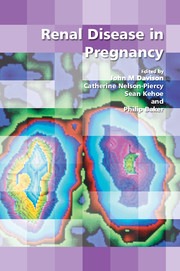Book contents
- Frontmatter
- Contents
- Participants
- Preface
- SECTION 1 RENAL PHYSIOLOGY IN PREGNANCY
- 1 Recent advances in renal physiology in pregnancy
- SECTION 2 PATTERNS OF CARE
- SECTION 3 CHRONIC KIDNEY DISEASE
- SECTION 4 DRUGS USED IN RENAL DISEASE IN PREGNANCY
- SECTION 5 ACUTE RENAL IMPAIRMENT
- SECTION 6 UROLOGY AND PREGNANCY
- SECTION 7 SURGICAL AND MEDICAL ISSUES SPECIFIC TO RENAL TRANSPLANT PATIENTS
- SECTION 8 CONSENSUS VIEWS
- Index
1 - Recent advances in renal physiology in pregnancy
from SECTION 1 - RENAL PHYSIOLOGY IN PREGNANCY
Published online by Cambridge University Press: 05 September 2014
- Frontmatter
- Contents
- Participants
- Preface
- SECTION 1 RENAL PHYSIOLOGY IN PREGNANCY
- 1 Recent advances in renal physiology in pregnancy
- SECTION 2 PATTERNS OF CARE
- SECTION 3 CHRONIC KIDNEY DISEASE
- SECTION 4 DRUGS USED IN RENAL DISEASE IN PREGNANCY
- SECTION 5 ACUTE RENAL IMPAIRMENT
- SECTION 6 UROLOGY AND PREGNANCY
- SECTION 7 SURGICAL AND MEDICAL ISSUES SPECIFIC TO RENAL TRANSPLANT PATIENTS
- SECTION 8 CONSENSUS VIEWS
- Index
Summary
Focus areas for this chapter
Mechanisms of increase in glomerular filtration rate
A robust and maintained renal vasodilation and increased glomerular filtration in pregnancy are good signs for both maternal and fetal outcome. In women with underlying chronic kidney disease (CKD), the level of prepregnancy renal function predicts outcome, with a serum creatinine (SCr) above approximately 120 μmol/1 signalling increases in maternal and fetal risks. The presence of hypertension and/or heavy proteinuria increases the risk of accelerated loss of function. If the rise in glomerular filtration rate (GFR) occurs and persists during pregnancy in a woman with underlying CKD, the pregnancy outcome will probably be good and pregnancy is likely to have little long-term impact on maternal kidney function. We still do not know the mechanisms that lead to the increased GFR or whether the requisite renal vasodilation is regulated separately from the systemic vasodilation that also occurs early in normal pregnancy.
What determines plasma volume expansion: primary vasodilation (underfill) or primary renal sodium retention and secondary vasodilation?
The systemic vasodilation is critical to accommodate the expanding plasma volume, another major haemodynamic event and prognostic of a successful outcome in both maternal and fetal terms. Does the peripheral vasodilation occur first and drive renal sodium retention and volume expansion, or does primary renal sodium retention begin the sequence of events?
- Type
- Chapter
- Information
- Renal Disease in Pregnancy , pp. 3 - 18Publisher: Cambridge University PressPrint publication year: 2008
- 1
- Cited by

